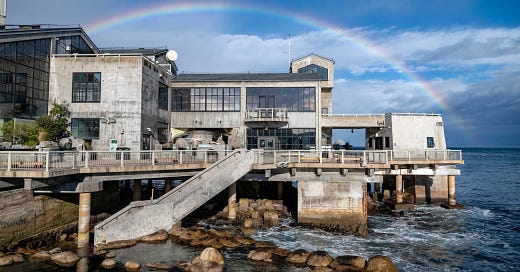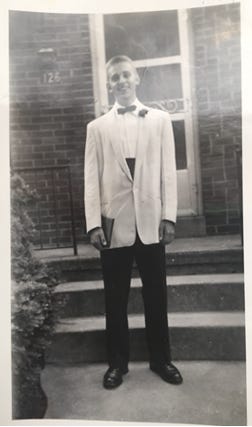Last week, my husband and I played hooky and took a day trip to the nearby Monterey Bay Aquarium. It’s an amazing place, full of breathtaking displays of the otherworldly life in tide pools and the open ocean. We particularly enjoyed watching the sea otters work their food out of plastic puzzles intended to keep their paws flexible and engage their minds. We touched a sea urchin, marveled at a transplanted kelp forest, and assigned anthropomorphic feelings of depression to Gerry, the only uncoupled penguin.
The aquarium is located at the end of cannery row, an area made famous by local writer John Steinbeck, whose tiny cabin is located just a stone’s throw from today’s museum. Though today, the area is billed as full of “luxurious waterfront hotels, enticing restaurants and captivating boutiques,” Steinbeck’s work reminds us that the area was once teeming with corrugated fish canning factories, where a largely immigrant population worked.

Starting in the early 1900s, a spike in demand for canned sardines during World War I sparked the growth of a boomtown that slowed during the Depression and was revived again for World War II, just long enough to decimate the sardine population, sending the area into ruin. Restoration and revival efforts resulting in the tourist-friendly attractions that are there today began in the late 1960s.
Opened in 1984, with funding from the Packard family of Hewlett-Packard fame, the non-profit aquarium is located in a reconstructed and redesigned sardine canning factory that has earned architectural awards. Some of the equipment from that time is included in a display along with tanks of fish. The aquarium is renowned for its laser focus on the regional marine ecosystem and its research and ocean conservation projects have influenced the field, including helping to designate Monterey Bay a federally protected marine sanctuary. Their Seafood Watch program helps consumers make sustainable choices when they are shopping or out to dine.
The “irony” of the aquarium’s location in the same building that played a significant role in overfishing has been noted since its inception. But I’d choose a different word: Hope.
History Today

“What is Juneteenth? A History of the Holiday in America” appeared in Good Housekeeping last year. Although the magazine has included articles in recent years that address systemic racism, launched in 1885 it also has a long history of potraying the few women of color on its covers with hypersexualization, objectification, likeness to whiteness and intensified exoticism (see this research thesis). But, while some believe that designating Juneteenth a federal holiday in 2021 was a weak response to the demands for racial justice from the Black Lives Matter movement and others, I appreciate the mainstreaming of the holiday and a very mainstream magazine’s attempts to put it in context for their readers. Read the article.
What I’m Reading
I was fascinated with the portrayal of John Muir in Guardians of the Valley, by Dean King (2023). His title as the “Father of the National Parks” is well-deserved, but he could also claim the title of the “Father of Extreme Sports.” Muir thought nothing of walking from Wisconsin to Florida in the mid-nineteenth century. After he moved West, he roamed up and down in the wilderness of the Sierra Nevada and Cascade mountain ranges in what we would call dress shoes, with nothing but a blanket and a hunk of bread. He weathered extremes of heat and cold without fleece or Gortex.
Most sobering about the book is the backstory of how the destruction of Yosemite’s twin valley—the Hetch Hetchy, which was damned for San Francisco’s water supply—became a cautionary tale that spurred the environmental movement. Additionally, the sheer volume of the lumber extracted from the coastal redwood forests is mind-numbing: Michigan lumber barons, who had exhausted their own supplies, for example, purchased a tract next to Yosemite with enough trees to yield “more than a billion board feet, enough to circle the earth with a foot-wide board nearly fifty times.”
Book News
During a recent visit to Palo Alto, I was pleased to see Folly Park on the shelf at Books Inc., which used to be my local bookstore (top shelf above my shoulder on the left). It’s quite rewarding to see it on a physical shelf (I had the same thrill on a recent trip to East Aurora, NY, where my mother has ensured her local store has it on the shelf near the door!). I think there’s something that my soul responds to with physical books—not just my own—that I just don’t get from a Kindle or iPad. I read recently that Gen Z has discovered the pleasures of “analog” (aka, “non-digital”) experiences like books and magazines, including records and stationery. Maybe we have something in common!
Origin Stories
Alan Charles Hackford (1957). Here’s a photo of my dad in honor of a belated Father’s Day and this season of graduations. He’s standing in front of his parent’s house holding his diploma from Canisius High School in Buffalo, New York. I’ve heard the name of that school for my entire life and just now wondered what it means. Apparently, it could be referring to Saint Peter Canisius (1521–1597), a Dutch Jesuit Catholic priest who wrote the famous Catechism and was a towering figure in the Counter-Reformation. Interestingly, the Latin root, “canis,” means dog. I’ll ask my dad if the priests ever explained the name.
Thanks for reading Living With History! Subscribe for free to receive new posts and support my work.








This is so ironic! I am literally in Monterey planning on going to the Aquarium tomorrow! I loved seeing the picture of your dad-my uncle! Love reading your posts very much! Posted by- Your cousin- Susi Hackford Furtado Matos!